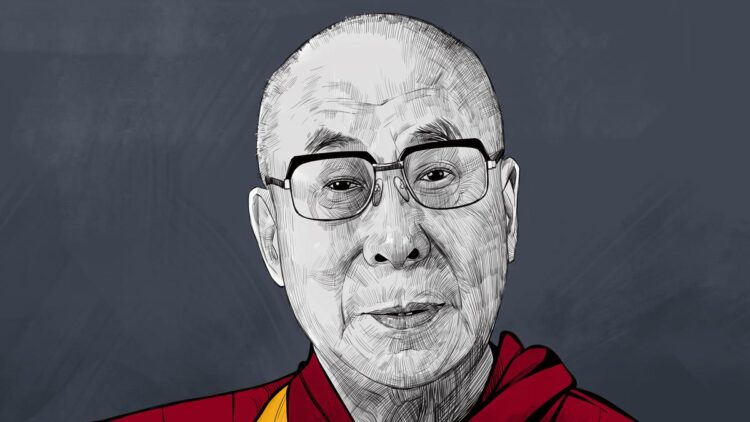[ad_1]
The 14th Dalai Lama always seems to remain in the news, more so for any leader of any community in exile or for that matter, any spiritual leader. Most recently, his office apologised for making inappropriate remarks to a child on video. The child was visiting him with family in Dharamsala on February 28 and the office stated that the Dalai Lama’s actions were “innocent” and “playful”. Later, Penpa Tsering, the head of Tibet’s “government-in-exile”, claimed, without proof, that “pro-Chinese sources” were responsible for “viralling” the video and argued that the “political angle of this incident cannot be ignored”.
The incident became a source of embarrassment for the 14th Dalai Lama, known to the Tibetan people as ‘Gyalwa Rinpoche’ and by the spiritual name Tenzin Gyatso. Born as Lhamo Thondup in 1935, he was identified as a reincarnation of the 13th Dalai Lama in 1937 and formally enthroned as the 14th Dalai Lama in 1940. The institution of the ‘Dalai Lama’ has been held as the spiritual leader of the dominant Gelug or ‘Yellow Hat’ school of Tibetan Buddhism. Each Dalai Lama is held as the custodian of the teachings of Avalokiteshvara, a bodhisattva (person in the path of bodhi or a form of Buddhist enlightenment) and an important deity in Tibetan Buddhism. The 14th Dalai Lama was both the spiritual and temporal ruler of Tibet till 1959, when he and his retinue fled to India, following unrest in the Tibetan capital of Lhasa, and have since stayed on as exiles and later formed a “government in exile”.
Also read | I am the ‘longest guest’ of India, says Dalai Lama
Currently, the Dalai Lama remains the most revered religious and spiritual figure for Tibetan Buddhists, besides having established a global celebrity of sorts after regular lectures and dialogues with Western leaders and civil society members in particular. Politically, however, he gave up political/temporal powers in 2011 to make way for a democratic “government in exile”, which now goes by the appellation, the Central Tibet Administration, but is seen as a non-profit political organisation and is not recognised as a sovereign government by any country.
The giving up of political powers marked a significant change. The tradition of the Dalai Lama leading the Tibetan government began with the fifth Dalai Lama, Ngawang Lobsang Gyatso, who in the early 17th century founded the “Gelugpa government”, which heralded a feudal theocratic rule that lasted until the early 20th century. The government had the Dalai Lama at the top, followed by a Cabinet headed by the Prime Minister. The government had a dual religious and civil structure, percolating down in a largely feudal system that held till the early 20th century.
The current government in exile, however, is modelled on an elected parliamentary system with judicial, legislative and executive branches and is primarily attentive to the welfare of the 100,000-odd Tibetan exile community in India. Most of the exiles stem from those who fled Tibet in 1959, eight years after communist China took control over Tibet.
Claim of suzerainty
Communist China had always held a claim of suzerainty over Tibet, which included the assertion that Tibet had become a “protectorate” of Manchu-ruled China in the late 17th century, as some Western historians have described as the relation between Tibet and the Chinese imperial state then. Even though Tibet enjoyed a “de facto” independent period in the early 1900s at a time of turmoil in China, the republicans and the communists retained a claim over Tibet being part of China and once the communists came to power with Mao Zedong’s leadership in 1949, the regime swiftly sought to secure the formal “reunification” of Tibet ruled by the Dalai Lama with China.
After Tibet refused to do so, the Chinese invaded Tibet’s eastern province in October 1950 and secured a 17-point “Agreement for the Peaceful Liberation of Tibet” in 1951” that “granted Tibetan recognition of Chinese sovereignty over Tibet for the first time in history”, as anthropologist Melvyn Goldstein puts it. The lacunae in the implementation of the agreement besides the uneasy coexistence of the communist regime and the theocratic Tibetan regime led to an uprising in Tibet, which also received covert support from the U.S. The uprising was put down and the Dalai Lama fled to India in 1959, along with 80,000 Tibetans.
From initially advocating independence for Tibet, the Dalai Lama has come a long way to now seek a version of Tibetan autonomy within China. The first contact between the exiled Tibetans and the Chinese leadership occurred in 1979, when the Dalai Lama’s elder brother visited Beijing to meet with Deng Xiaoping, who had by then become the paramount leader of post-Mao and post-Cultural Revolution China. Deng had then insisted that the basis for any discussion was that the Dalai Lama had to accept that Tibet was an integral part of China.
Forthcoming talks between the Dalai Lama’s representatives and the Chinese government — much of it held in secret — revealed the significant gap in their positions. The exiles sought to operate a political system in Tibet that was different from the communist regime, besides seeking greater autonomy and an expansion of the autonomous region into other provinces of western China where ethnic Tibetans reside. The negotiations collapsed due to the differences but the Dalai Lama sought to drum up international support through speeches as a political leader of the Tibetans — the most prominent of which was the Strasbourg speech in 1998 where he argued for “Greater Tibet” to be a self-governing democratic entity but enjoying a dominion status within the Chinese nation-state.
Also read | China failed to change Tibetan people’s minds, says Dalai Lama
The Chinese government went on to refuse these demands, continuing to term the Dalai Lama a “splittist”, by expressing wariness over the expansion of the autonomous region, a complete refusal of a different political system for Tibet as envisaged by the exiles and a denial of the idea of extending the “one country, two systems” formula.
Persistent unrest
Following persistent unrest in Tibet in the late 1980s, Beijing went on to intensify its political control and repressive measures while embarking upon economic modernisation in line with the reforms that were underway in China, even as it continued to promote greater cultural rights for Tibetans. This resulted in an economic boom in the tourism and construction sectors in Tibet, enriching the rising middle class in the region, but also allowing for a non-Tibetan population to increase in the region to the benefit, in particular, of Han Chinese traders.
The Dalai Lama has since these developments sought to amplify his “middle way” — seeking a non-violent resolution of the ‘Tibetan question’, moderate and modernise the political and temporal aspects of the Tibetan organisation in exile and greater autonomy for Tibetans within Tibet.
He has, besides this, engaged in spiritual dialogue with the West in particular to promote the “universalising” values of Buddhism that include non-violence, the abolition of death penalty and religious harmony among others. This has earned him substantial popularity globally.
In recent years, the Dalai Lama has speculated on the reincarnation of his successor by even suggesting that the custom of recognising “reincarnate lamas may have had its day” because of its feudal origins and incongruence with democratic society. This has not deterred the Chinese government to begin preparing the process of selecting the next Dalai Lama, a tacit admission that despite several changes in Tibet and the relatively low number of protests against communist rule in recent years, the institution of the Dalai Lama continues to have a significant hold over Tibetans, both within and outside Tibet.
[ad_2]
[ad_1]
The 14th Dalai Lama always seems to remain in the news, more so for any leader of any community in exile or for that matter, any spiritual leader. Most recently, his office apologised for making inappropriate remarks to a child on video. The child was visiting him with family in Dharamsala on February 28 and the office stated that the Dalai Lama’s actions were “innocent” and “playful”. Later, Penpa Tsering, the head of Tibet’s “government-in-exile”, claimed, without proof, that “pro-Chinese sources” were responsible for “viralling” the video and argued that the “political angle of this incident cannot be ignored”.
The incident became a source of embarrassment for the 14th Dalai Lama, known to the Tibetan people as ‘Gyalwa Rinpoche’ and by the spiritual name Tenzin Gyatso. Born as Lhamo Thondup in 1935, he was identified as a reincarnation of the 13th Dalai Lama in 1937 and formally enthroned as the 14th Dalai Lama in 1940. The institution of the ‘Dalai Lama’ has been held as the spiritual leader of the dominant Gelug or ‘Yellow Hat’ school of Tibetan Buddhism. Each Dalai Lama is held as the custodian of the teachings of Avalokiteshvara, a bodhisattva (person in the path of bodhi or a form of Buddhist enlightenment) and an important deity in Tibetan Buddhism. The 14th Dalai Lama was both the spiritual and temporal ruler of Tibet till 1959, when he and his retinue fled to India, following unrest in the Tibetan capital of Lhasa, and have since stayed on as exiles and later formed a “government in exile”.
Also read | I am the ‘longest guest’ of India, says Dalai Lama
Currently, the Dalai Lama remains the most revered religious and spiritual figure for Tibetan Buddhists, besides having established a global celebrity of sorts after regular lectures and dialogues with Western leaders and civil society members in particular. Politically, however, he gave up political/temporal powers in 2011 to make way for a democratic “government in exile”, which now goes by the appellation, the Central Tibet Administration, but is seen as a non-profit political organisation and is not recognised as a sovereign government by any country.
The giving up of political powers marked a significant change. The tradition of the Dalai Lama leading the Tibetan government began with the fifth Dalai Lama, Ngawang Lobsang Gyatso, who in the early 17th century founded the “Gelugpa government”, which heralded a feudal theocratic rule that lasted until the early 20th century. The government had the Dalai Lama at the top, followed by a Cabinet headed by the Prime Minister. The government had a dual religious and civil structure, percolating down in a largely feudal system that held till the early 20th century.
The current government in exile, however, is modelled on an elected parliamentary system with judicial, legislative and executive branches and is primarily attentive to the welfare of the 100,000-odd Tibetan exile community in India. Most of the exiles stem from those who fled Tibet in 1959, eight years after communist China took control over Tibet.
Claim of suzerainty
Communist China had always held a claim of suzerainty over Tibet, which included the assertion that Tibet had become a “protectorate” of Manchu-ruled China in the late 17th century, as some Western historians have described as the relation between Tibet and the Chinese imperial state then. Even though Tibet enjoyed a “de facto” independent period in the early 1900s at a time of turmoil in China, the republicans and the communists retained a claim over Tibet being part of China and once the communists came to power with Mao Zedong’s leadership in 1949, the regime swiftly sought to secure the formal “reunification” of Tibet ruled by the Dalai Lama with China.
After Tibet refused to do so, the Chinese invaded Tibet’s eastern province in October 1950 and secured a 17-point “Agreement for the Peaceful Liberation of Tibet” in 1951” that “granted Tibetan recognition of Chinese sovereignty over Tibet for the first time in history”, as anthropologist Melvyn Goldstein puts it. The lacunae in the implementation of the agreement besides the uneasy coexistence of the communist regime and the theocratic Tibetan regime led to an uprising in Tibet, which also received covert support from the U.S. The uprising was put down and the Dalai Lama fled to India in 1959, along with 80,000 Tibetans.
From initially advocating independence for Tibet, the Dalai Lama has come a long way to now seek a version of Tibetan autonomy within China. The first contact between the exiled Tibetans and the Chinese leadership occurred in 1979, when the Dalai Lama’s elder brother visited Beijing to meet with Deng Xiaoping, who had by then become the paramount leader of post-Mao and post-Cultural Revolution China. Deng had then insisted that the basis for any discussion was that the Dalai Lama had to accept that Tibet was an integral part of China.
Forthcoming talks between the Dalai Lama’s representatives and the Chinese government — much of it held in secret — revealed the significant gap in their positions. The exiles sought to operate a political system in Tibet that was different from the communist regime, besides seeking greater autonomy and an expansion of the autonomous region into other provinces of western China where ethnic Tibetans reside. The negotiations collapsed due to the differences but the Dalai Lama sought to drum up international support through speeches as a political leader of the Tibetans — the most prominent of which was the Strasbourg speech in 1998 where he argued for “Greater Tibet” to be a self-governing democratic entity but enjoying a dominion status within the Chinese nation-state.
Also read | China failed to change Tibetan people’s minds, says Dalai Lama
The Chinese government went on to refuse these demands, continuing to term the Dalai Lama a “splittist”, by expressing wariness over the expansion of the autonomous region, a complete refusal of a different political system for Tibet as envisaged by the exiles and a denial of the idea of extending the “one country, two systems” formula.
Persistent unrest
Following persistent unrest in Tibet in the late 1980s, Beijing went on to intensify its political control and repressive measures while embarking upon economic modernisation in line with the reforms that were underway in China, even as it continued to promote greater cultural rights for Tibetans. This resulted in an economic boom in the tourism and construction sectors in Tibet, enriching the rising middle class in the region, but also allowing for a non-Tibetan population to increase in the region to the benefit, in particular, of Han Chinese traders.
The Dalai Lama has since these developments sought to amplify his “middle way” — seeking a non-violent resolution of the ‘Tibetan question’, moderate and modernise the political and temporal aspects of the Tibetan organisation in exile and greater autonomy for Tibetans within Tibet.
He has, besides this, engaged in spiritual dialogue with the West in particular to promote the “universalising” values of Buddhism that include non-violence, the abolition of death penalty and religious harmony among others. This has earned him substantial popularity globally.
In recent years, the Dalai Lama has speculated on the reincarnation of his successor by even suggesting that the custom of recognising “reincarnate lamas may have had its day” because of its feudal origins and incongruence with democratic society. This has not deterred the Chinese government to begin preparing the process of selecting the next Dalai Lama, a tacit admission that despite several changes in Tibet and the relatively low number of protests against communist rule in recent years, the institution of the Dalai Lama continues to have a significant hold over Tibetans, both within and outside Tibet.
[ad_2]
















